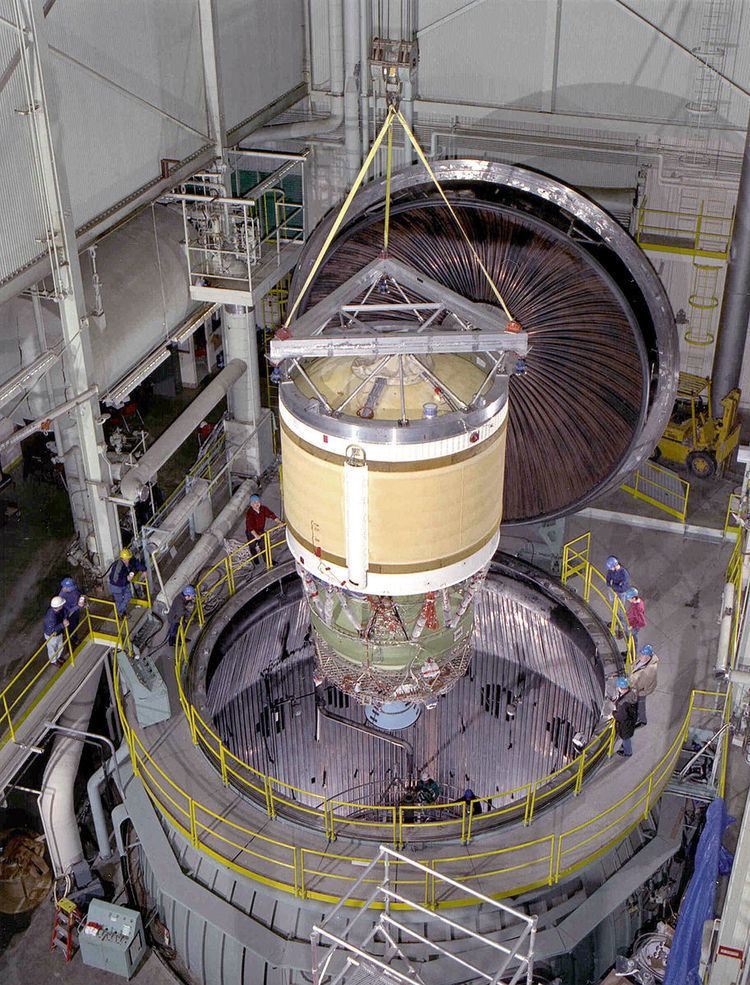Country of origin United States Diameter 4 m (13.1 ft) | Height 35 m (114 ft) | |
 | ||
Mass 301,450 kg (664,580 lb) | ||
The Delta III rocket was an expendable launch vehicle made by Boeing. The first Delta III launch was on August 26, 1998. Of its three flights, the first two were failures, and the third, though declared successful, reached the low end of its targeted orbit range and carried only a dummy (inert) payload. The Delta III could deliver up to 8,400 pounds (3,800 kilograms) to geostationary transfer orbit, twice the payload of its predecessor, the Delta II. Under the 4-digit designation system from earlier Delta rockets, the Delta III is classified as the Delta 8930.
Contents
Vehicle description
Like the Delta II, the first stage of the Delta III burned kerosene and liquid oxygen and was powered by one Rocketdyne RS-27A main engine with two vernier engines for roll control. While the propellant load and gross mass of the stage were nearly identical to the Delta II, the diameter of the kerosene tank was increased from 2.4 meters to 4 meters. This reduced the overall length of the vehicle and allowed the Delta III to use the same launch facilities as the Delta II with only minor modifications.
First stage thrust was augmented by nine GEM-46 solid rocket boosters, sometimes referred to as GEM LDXL (Large Diameter Extended Length). These were 14.7 meters in length, 1.2 m (46 inches) in diameter, and had a mass of 19 metric tons each, about 6 metric tons more than the Delta II's standard GEM-40 motors. Six were ignited on the launch pad, while the remaining three were ignited just before burnout and separation of the ground-lit boosters. To maintain steering authority, three of the boosters had vectoring nozzles. GEM-46 boosters would later find use on the Delta II, leading to the Delta II Heavy.
The second stage of the Delta III was the newly developed Delta Cryogenic Second Stage (DCSS), which burned liquid hydrogen and liquid oxygen. The liquid hydrogen tank was 4 meters in diameter, while the separate liquid oxygen tank was 2.4 meters in diameter. This stage offered significantly better performance than the Delta II's second stage, the Delta-K, which burns hypergolic propellants. The DCSS was powered by a Pratt & Whitney RL10B-2 engine, derived from the RL10 powering the Centaur upper stage but featuring electromechanical actuators for gimbal control and an extending nozzle for increased specific impulse. After Delta III's retirement, this stage was modified for use as the Delta IV's second stage.
The payload fairing was a new composite design, matching the upper stage hydrogen tank at 4 meters diameter and allowing larger payloads than the Delta II's 9.5 or 10 foot fairing.
Payload to GTO (Geostationary-Transfer Orbit) was doubled versus the Delta II but the consecutive failures of the initial Delta IIIs, combined with the more-advanced Delta IV program and the continuing success of the Delta II, left the Delta III as an interim vehicle.
Launches
Delta Flight 259: The inaugural launch on August 26, 1998 from Cape Canaveral Air Force Station ended in failure, when software adapted from the Delta II caused a guidance failure during first-stage flight. The failure and subsequent vehicle motion depleted the hydraulic fluid used for steering.[1] Upon loss of control, the vehicle was destroyed. The Galaxy X satellite (Hughes HS601 HP type) was destroyed.
Delta Flight 269: The second launch on May 4, 1999, carrying the Orion 3 satellite (Hughes HS601 model), also ended in failure. The second stage engine experienced a pressure anomaly and rupture, and shut down while its second burn was underway, leaving the payload in a useless orbit.
Delta Flight 280: The third and final flight on August 23, 2000 launched a 4,348 kg (9,586 lb) satellite simulator into a 180.76 x 20,694 km orbit. While the apogee was 2,710 km lower than the targeted 185 x 23,404 km, it was within the allowable 3,000 km margin of error and demonstrated the propellant depletion shutdown capability of the DCSS, modified versions of which would become the second stage of the Delta IV.
